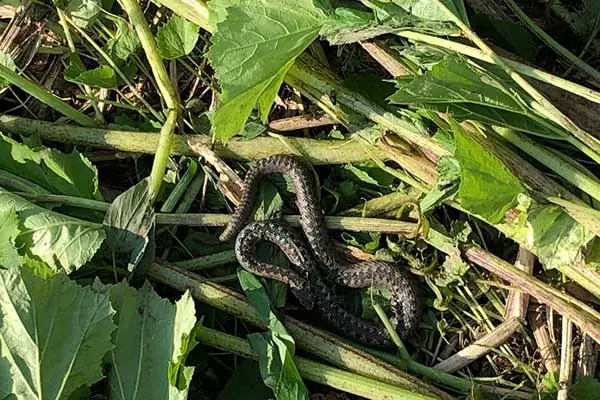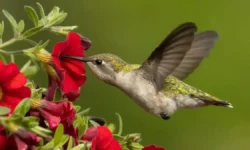How do you feel about snakes? Don’t they sound scary? Obviously, they are.
Did you know, that few snakes are not as harmful as they seem to be? The Garter Snake is one of them.
Do you want to meet this snake? Right here, on this article page, we are going to invite this friendly snake. Have big applause, let’s welcome the amazing creature Garden or Garter snake. Claps!!!
Come on, at first talk about its appearance.
What does a gardener snake look like? Generally, Garden or Garter snakes have wide heads, striped colorful body patterns, and a red tongue. Most of its species are harmless and nonvenomous. They mostly live near wet soil near plantations, woodlands, farms, yards, and grasses. They are found in North America, Canada, Mexico, and Central America.
Let me introduce it a bit more!
They belong to the genus Thamnophis of the animal kingdom. Probably, they got this name after stocking garter or frequent appearances in gardens. But not sure what was the exact story behind this name.
How are you, Mister Snake? Would you like to tell us more about your fantastic appearance! Why not, move on!
Table of Contents
Physical Appearance of Common Garden Snakes
Though friendly but aggressive when touched!
Does it look like other snakes or something is different? Let’s find out physical characteristics that you can note in just a glance.
So, get through one by one!
Length of a Garden Snake
Curious to know how long this snake can be? It can be as long as 137cm and as short as 46cm depending on habitat and species. Wow…long enough!
Primarily the length of animals is based on the genetics of the species. Sometimes health factors and food availability also play a vital role in the rapid growth of the snakes. We can say garters are not too long to be visible from a long distance and not too short to be invisible. If you wanna identify it through its length, you should have proper knowledge of measuring long and bent objects. They tend to keep their bodies embedded or folded; it’s challenging to make the right guess about its length at a glance.
Color of a Garden Snake
They come in a wide range of colors. Awesome!
They are yellow, red mud-colored, green or blue, gold, red, orange, brown, and black. The Colour contrast in Ribbon garters is impressive. The stripe and underlines are always of the same color. Whilst background sometimes changes depending on species. However, it is an important fact to note that not all species are colorful. Some of them have only one color and are stripeless.
Haven’t you seen Santa Cruz’s Snake species of garter? It’s really adorable with bright color contrast. With just a single glance, you will fall in love with its fancy colors.
What’s great about the colorful body of this snake is that sometimes these colors create a camouflage-like sensation. For example, if a snake’s color matches the earth, predators will not prey on it at all.
Weight of a Garden Snake
Not too heavy! You can carry it easily. Will you try it? No, no.
Who loves to carry them?
Obviously, researchers do it to collect data to help us provide knowledge about every aspect of an animal’s life. Similarly, zoologists know techniques to weigh them as well as measure them for length.
What do studies tell about garden snake weight? Let’s find out.
The average weight of a typical garter is approximately 140grams. It varies on the species and health and age of the animal. Females put weight on reproduction. Babies are low-weight animals. As they grow up, they gain weight and strength.
Body Pattern of Garden Snake
Don’t miss this factor as it can help you to make the right guess!
One of the most common patterns in garter snakes is a stripe pattern. These stripes are yellow in color and run down from the top of the head to the tail. In common garter, the color of a stripe may vary. It can be a color contrast of yellow stripes on a black background. Sometimes the background can be green with brown stripes. However, few species are stripeless and have only one color. These patterns are really handy and seem as if they originated from the pen of expert artists.
Table of Different patterns in Garter Snakes with Images:
Snake Name | Pattern | Image |
Common garter snake | Yellow stripes on a black background | |
Coastal garter Snake | White middle stripe with black spots on a red background | |
Eastern black-necked garter snake | Orange stripe on black and white background | |
Red striped ribbon snake | Red striped in the middle with a ribbon pattern of a brown background and yellowish underlines. |
Identification of Garden Snakes: Tips & Fact
Ouch, snake, snake!
Do you shout like that whenever you spot one in your garden? Obviously, many people do this. Why? Just because they know less about snakes.
Not all types of snakes are venomous and aggressive. But they can be harmful if you tease them. How can you identify which type of snake have you spotted recently in your yards is Garter or not?
For this, follow the steps below:
Where to Find Garter Snake in Your Garden
There are specific points where you can track garter. They usually move around during the daytime. So the best time is to start your work in daylight.
Here are a few tips that may help you to detect them!
- If you are living in North America, Florida, or California, then there is an 80 percent possibility that the snake you would spot in your backyard is a garden snake. Because they are natives of Northern America and many other states where people love plantations.
- Humidity in soil provides the best habitat for the garden snake. Near the plantation, the land remains moist. So there is a great chance to find them near water, woodlands, meadows, grasses, and other underside areas where they can hide.
- If there are so many snails, salamanders, and pests invading your planting area, then there is a possibility of invading garter snakes too. Because they eat all types of pests, insects, rodents, and even worms. So keep an eye on the pests in your garden as well.
- Are there lots of hiding places, and debris undersides available in your farmlands? If yes, then a garden snake can easily make its home thereby. Once they lose your sight when you spot them, they aren’t easy to find again.
- Remember, garters don’t dig burrows or holes in the mud. However, they invade other animals’ dens. So, if there are holes or cracks in your garden, then it is a possibility of their appearance nearby. Naughty!
Major Signs of Presence of Garter Snake
When to ring alarm bells for garden snake presence? Know from here. We’ve gathered a few significant alarming signals that will help you to trace them and detect them. If you are the owner of the lush planted area, then keep an eye on these alarm bells.
- If there is a kind of continuous hissing sound in your grassy plot, then there might be a possibility that the garden snake lives there. They make sounds through their nostrils. But it’s not easy of a powerful clue as many pests also make a hissing sound. However, it can be a less reliable sign.
- Keep an eye on the mud of your garden if there are slithering tracks then it would be a snake nothing else.
- Garden snakes produce stinky odors from the tail when they sense danger. If you feel an unpleasant smell or musk then it’s another indication of their presence.
- If you find a piece of shed off old skin of garter near a plantation or holes, then it would be garter nearby. As they grow up, they must shed their old skin, which you can find anywhere.
How to Identify of Garter Snake
Suppose you come across a scary snake in your garden then what to do now. How to tell whether it’s a garter or someone else? We’ve got a few tips that will help you to identify them easily.
Let’s carry on!
Relax! No need to shout as snakes don’t hear sounds; they can just feel the vibration. Keep your nerves under control. Don’t run; just move to a safe distance if the snake is nearby. Your fear can be the primary hindrance in your way to identify the snake. So, overcome it and start your work.
Check its body pattern. If there is one stripe that runs down from the center of the snake’s back and two stripes at both sides of its body, then it will surely garter. However, few species don’t have stripes at all but they are still garters.
They come in a variety of color contrasts. You can find yellow stripes on a black background. Sometimes you can find multi color ribbons like stripes. They can be red, green, yellow, orange, grey, and even muddy or dusty in color. The belly stripe and throat stripe would have the same color.
They release an unpleasant odor from their tails if you approach them, But this type of identification test can be harmful. Don’t try to go near them. Just feel the odor around the area near to them.
Now it’s time to focus on the head of the snake. Its head is darker and relatively wider than the neck. It can even attack from a distance as the head area better supports it. So, maintain a safe distance during the detection process.
The tongue of the garter is unique and can be a big clue to recognizing it. Commonly, garters have a red tongue with black tips
After checking its appearance, it’s time to confirm whether it is garter or not. Google the physical appearance of your spotted snake and make sure that it was a garden snake and nothing else. Match all the data about color, tongue, pattern, size, and habitat, and then verify your guess.
Before approaching any snake, it’s essential to know whether it’s venomous or not? The good news is that garter can bite but is harmless and nontoxic. But it does not matter that there will be zero side effects of its sting. It may cause body ache, redness, or even severe symptoms in low immunity persons.
Related Articles: how to get rid of flatworms in the garden?
Types of Garden snakes with picture
What do different species of garter look like? Important query!
To make it easy for you to identify it species-wise, we’ve gathered images of well-known species with the name. Have a look, at the table below!
There are about 35 different types of garter snakes known so far. They are classified on the basis of color, shape, size and habitat, availability of food, range, and legal status. Scientists collect these data very carefully and keep records of them from year to year. Whenever they observe some new species they categorize it according to their set rules. Don’t miss watching the Species spotlight video of a garter snake.
Here we are going to share images of Garter Species with names .
Table of Species of Garter Snake With Names & Images
Garter Snake Species Names | Image | Garter Snake Species Names | Images |
Santa Cruz garter Snake | Common Garter Snake | ||
Bogert’sgarden snake | Northwestern Garter Snake | ||
A short-headed garden snake | Tepalcatepec Valley Garter Snake | ||
Butler’s garter snake | Western Ribbon Snake | ||
Golden-headed garter snake | Yellow-throated Garter Snake | ||
Conant’s Garter snake | Plains Garter Snake | ||
Sierra garter snake | Narrow-headed Garter Snake | ||
Black-necked garter snake | Eastern Ribbon Snake | ||
Western terrestrial garter snake | Meso American Highlands garter snake | ||
Mexican garter snake | Giant garter snake | ||
Giant garter snake | Madrean Narrow-headed Garter Snake | ||
Godman’s garter snake | Mexican Pacific Lowlands Garter Snake | ||
Two striped garter snake | Mexican black-bellied garden snake | ||
Liner’s garter snake | Checkered garter snake |
Species of Garter Snakes Found in Different Countries
Are you searching which species of garter invade your country? If you live in the US, common garter, Plain Garter, and Two-Striped Garters are commonly found here. In Canada, you may spot Eastern Ribbon as well as Common Garter most often. In Mexico, Mexican Garter and Black-Necked Garter are well known.
Let’s check out an interesting table in which you can learn more about species found in different countries.
Table of Garter Species and Country Names Where They Live
Country Names | Types of Garter Snake found there |
US(Arizona,Alaska,California,Indiana,Idaho, | Eastern Ribbon, Common garter, Santa Cruz garter Snake, Sierra garter snake, giant garter, two striped garters, common garter, Checkered garter,black-necked, western terrestrial,narrow-headed, Mexican garter, plains garter snake, Butler’s garter snake, and many more |
Canada(Manitoba,Alberta,Quebec,Ontario,Nova Scotia) | Western terrestrial, plains garter, common garter, Butler’s garter snake, Eastern ribbon snake |
Mexico(Aguascalientes,Baja California,Morelos,Colima) | Black-necked garter snake, Mexican garter snake, Mexican black-bellied garter snake, Yellow-throated garter snake, Mexican pacific low land garter snake |
Central America(Belize,Costa Rica,EL-Salvador,Guatemala,Honduras) | Checkered snake, western ribbon snake, mesoamerican highland garden snake. |
Difference Between a Garden snake or Garter Snake
Are you confused between garter and garden snake terms? Do you think both words refer to the same word or are different? Is your mind occupied with such queries?. Let’s move into the truth of the matter with us
There is no difference between the Garter and the Garden snake. The garter is the actual name of the snake that mostly lives in gardens or yards. These are two names of the same creature. Whatever term you may choose to call this snake type, meaning will be the same.
Gardens are a favorite place for garters because they can find enough food and moist soil here. They can hide under plantations. Most of their species are the color of earth and can get the camouflage-like sensation from the gardens. Because of their typical habitat, they can be both termed garter or garden snakes. Right?

How Does a Baby Garden Snake look Like
Good news!No eggs no larva, no mess up!
Females give birth to fully developed 20 to 40 offspring at once. Amazing! In some species, this number may vary as they can give birth to even 4 to 80 babies also.his type of reproduction is called ovoviviparous.
Apparently, baby snakes are thin not much long after birth. But they are fully developed and will retain the same color and stripe pattern throughout their life. They are aggressive and can bite if touched. But their bite is not much harmful. However the odor they produce when someone approaches them can cause allergic reactions. After birth, they stay with the mother for up to 2 weeks. After shedding their first skin cover, they will start to live on their own.
How Does Male & Female Garter Snakes Look Like
Wanna go deeper in your search! Now try to recognize gender! Stay with us!
Apparently, both male and female snakes look the same. But if you focus more, you will observe girls are longer than boys and even bulkier. Sounds funny!
Males can reach 16-24 inches in length while females can go beyond 30-36 inches long. Reverse phenomena, unlike humans!
Though both brother and sister look the same yet, their tails are a bit different. The tail of females reduces in thickness at the end whilst males have a relatively thicker tail on the end.
For Snake lovers, here is an interesting book for you if you want to read more about them.
Final Verdict
It’s time to say Bye-Bye to Garter Snakes for a while. We will come again with the latest info about this creature soon. Before leaving, I would love to advise you that this animal is peaceful, never kill it. If you are still scared, then call wildlife authorities, they will catch and set it free in areas away from the population. Some of its species are already on the borderline of extinction. If you would hate or kill them, then our ecosystem will be destroyed. Save animals, save the environment!






